How to Train a Dog Not to Bite – An Essential Guide
Published: Last updated: by Jessi Larson Affiliate Disclosure: We hope you love the products we've recommended! As an Amazon Associate we earn a small share from qualifying purchases.Dogs have many wonderful qualities but there’s a potential downside, and it’s a big one: Biting. This harmful behavior can be dangerous and even deadly, which is why it’s all the more important to learn how to train a dog not to bite.
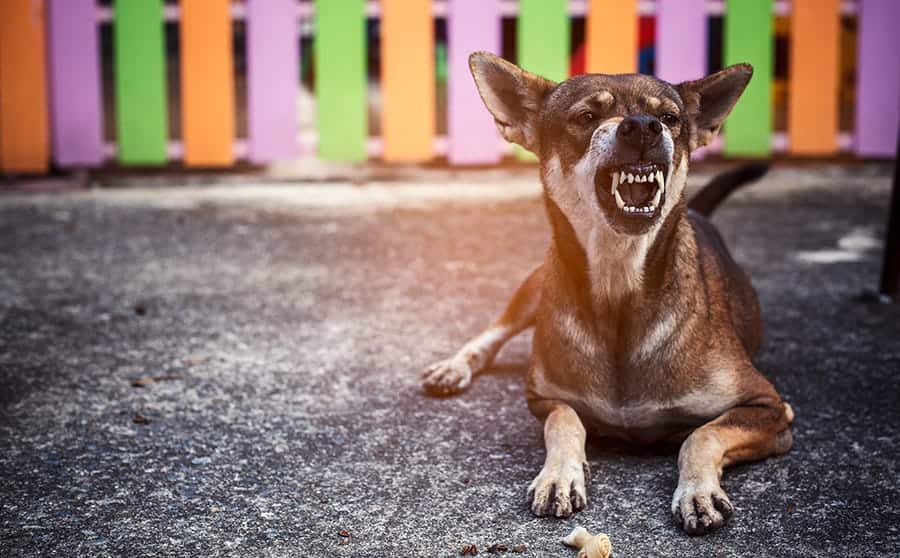
Behavior Guide: How to Train a Dog Not to Bite
Biting can be a common but problematic behavior that can occur in all dogs. However, in most cases, there are many ways to control and eliminate biting behavior before it develops into an issue. Here are some important pointers.
1. Establish Leadership
The most important thing when training a dog is to establish yourself as the pack leader, or the alpha of the pack – even if that pack consists of just you and your dog.
To establish yourself as an authority, practice by walking your dog around by a leash (ideally at home) and teach your dog to “heel,” or follow you and defer to your commands.
Offer positive reinforcement when your pup follows your rules.
2. Start with Early Socialization
Biting, as a form of aggressive or fearful behavior, can be considerably limited with consistent and early socialization.
This means exposing your pup to as many new situations and people as possible at an early developmental stage so that it is less likely to react fearfully with a bite.
If you are working with an adult dog, socialization is still possible, but should be done with the help of a professional trainer, especially if your dog is exhibiting fearful or aggressive behavior.
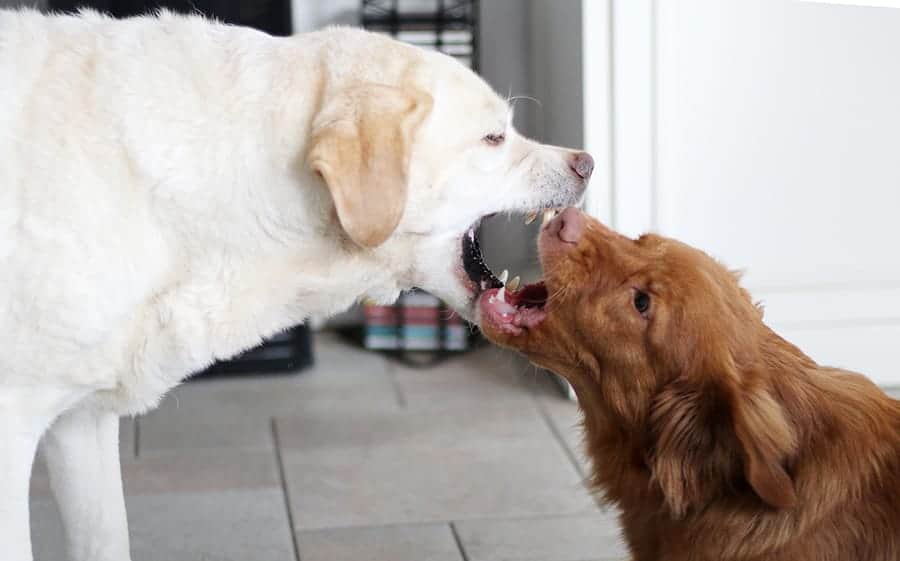
3. Prevent Biting During Play
Puppies are notorious for chewing up everything in sight – sometimes that can include your fingers and toes.
For dogs, biting is a natural behavior that isn’t just a product of aggression, but can often used during play as well. However, you should teach your pup early on that this behavior doesn’t extend onto people. This is done by setting early behavioral limits during playtime.
If your puppy nips at your hand or tries to bite you during play, stop what you’re doing immediately and give your dog some time to calm down. You can go even further to tuck your hands under your armpits, which signals your withdrawal from playing.
Only approach them again when the biting has stopped and reward positive behavior. Never punish or use aggression with your dog when training. You should also avoid rough play with your dog that might encourage biting behavior.
4. Spay/Neuter on Time
While there’s technically no guarantee that spaying or neutering your dog will prevent them from biting, there is evidence that fixed dogs are less likely to become aggressive.
Plenty of other reasons to get your dog spayed or neutered obviously exist, but preventing potentially aggressive behavior should be at the top of the list.
5. Don’t Assume a Dog Won’t Bite
As we said, biting is a natural instinct and behavior in dogs, so any dog can potentially bite someone if the “right” circumstances arise.
All this is to say, that even if you know a dog to be docile and otherwise unaggressive, you should never discount their potential to bite.
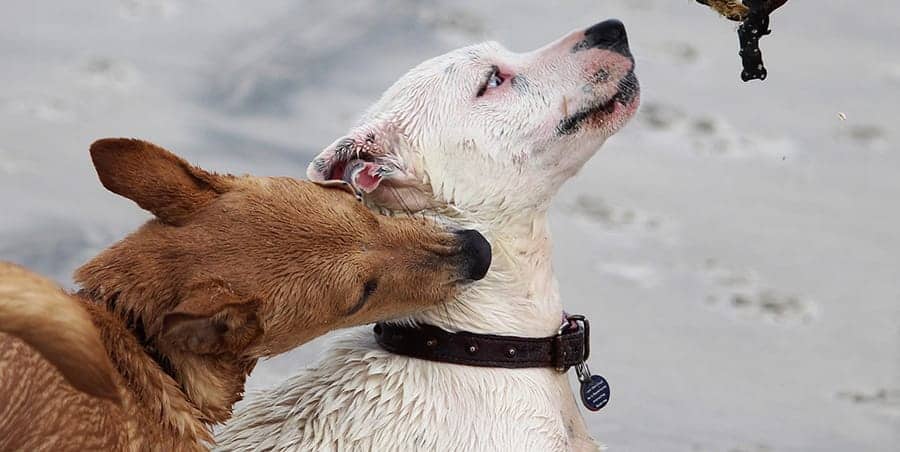
6. Focus on Obedience Training
An obedient, well-trained dog is less likely to be nervous and get out of control.
So even if a tense situation does arise, you’ll be able to better contain your dog’s aggression and re-direct their attention before they strike.
Training will also boost your dog’s confidence and promote a more calm and happy demeanor.
7. Read Your Dog’s Body Language
Your dog speaks through its body language, so if you really want to know how they are feeling, just study the posture.
If you sense your dog is in distress or unhappy in a situation, this could potentially lead to aggressive behavior, so give your dog space, and try to change their environment to where they can be comfortable and free from distress.
8. Pay Attention to Growling
Just like body language, you should also pay attention to your dog’s growls. Many dog owners confuse this communication for unwanted aggression, so they try to stop it.
The fact is, your dog’s growl is a warning that they don’t like something around them and feel threatened. Growling alone isn’t an aggressive behavior but it can signal that aggressive behavior may be coming.
That is why it’s important to listen to what your dog is communicating to you so you can remove them from whatever danger they perceive.
If you stop the growling, on the other hand, this may result in your dog going straight in for the bite without any prior vocal warning.
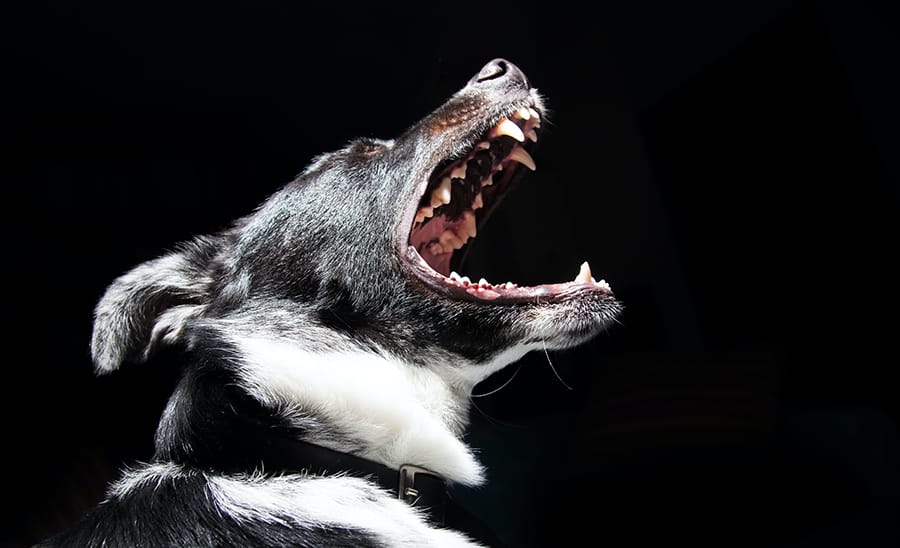
9. Use Positive Reinforcement
When training your dog, it’s very important not to resort to using any negative reinforcement or punishment. While some dog owners think this type of stern approach will get them better results, that isn’t actually the case.
In fact, a study published in the Journal of Applied Animal Behavior in 2009 found that dogs that were trained with negative reinforcement were actually 25% more likely to exhibit aggressive behavior toward humans.
Instead, you should focus on giving plenty of positive reinforcement to your dog that encourages and celebrates their good behavior.
Positive encouragement is anything that gives pleasure to your dog, such as petting, verbal praise, extra play, a toy or a treat.

Final Thoughts on How to Train a Dog Not to Bite
We hope these tips help show you how to train a dog not to bite. Ultimately, you should always be aware that no two dog’s personalities are the same, and it’s important to take precautions and proactive steps to discourage any aggressive behavior.
However, if your dog has already bitten you or anyone else, or shows signs of aggressive behavior, you should seek out the help of a professional trainer to address these issues.
Watch a Training Video
As you learn how to train a dog not to bite, it can often help to get reinforcement through videos. After all, most people are more visual learners.
At My Dog’s Name, we love dog trainer Zak George. His positive, fun and informational style makes it easy to learn.
He has a wide variety of training videos to check out, including a number on the topic of how to train a dog not to bite.
If you have a puppy who won’t stop nibbling, this video is a good resource.
And if you find your dog continues to snap at people and other animals – a dangerous habit you need to stop ASAP – this video can help provide relief.
Bonus Training Tip
As you work on how to train a dog not to bite, you may get frustrated or impatient at times. But remember, dogs respond negatively to aggression and it negates your training.
Intelligent and intuitive creatures, dogs can sense if you’re hyper or angry, so taking a few moments to regroup will make the training process more successful.
If you feel like you’re at your wit’s end, just take a time out, breathe deep and count to 10. This will help you feel refreshed and ready to start again.
However, it’s important to note that you should do this after the bad behavior has stopped. Always make sure your dog is not a threat before pausing to regroup.
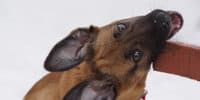


 Getting a New Dog?
Getting a New Dog?
1 Comment
I seem to be having a hard time finding a course specifically to train my dog not to bite when he is chewing on something he should not have. When we go to take it away he bites with no warning, where is this covered in your program?